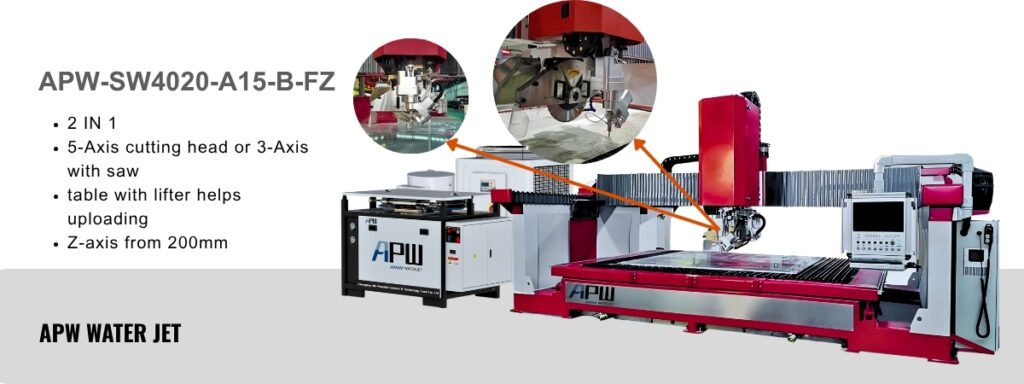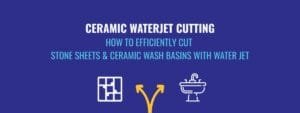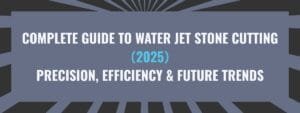In the stone processing industry, water jet cutting technology is reshaping production models with its composite processing advantages. By integrating the high efficiency of traditional sawing and the precision of water jet cutting, this technology has become a key choice for many enterprises to enhance production capacity and optimize cost structures. The following analysis combines industry practical experience to interpret its core value and application trends.
This article is only for reference – for personalized assistance. Contact APW WATER JET SALES. It is every machinery provider’s obligation to help customers maximize profits.
watch water jet cutting videos / download catalogs / check technology data
I. Technical Selection Logic: Dual Drivers of Efficiency and Cost
The core motivation for stone processing enterprises to introduce water jet cutting equipment focuses on efficiency improvement and cost optimization. For example, a design center case points out that the integrated water jet cutting machine reduces material handling costs significantly by integrating sawing and water jet functions, while improving stone material utilization through efficient nesting. Practice in another enterprise shows that this technology is highly effective in reducing labor input and equipment maintenance costs—for faucet hole cutting alone, each hole can save tooling costs.
For large-scale production scenarios, the automation capability of equipment is particularly important. A factory deployed two water jet cutting machines, needing to complete approximately 186 square meters of processing daily. By assigning 80% of straight-line cutting to the saw blade and leaving complex contours to the water jet, it ensures speed (full-size cutting of a single stone slab takes only 20–30 minutes) while maintaining an accuracy level of ±0.1mm, adapting to fully automated production needs.

II. Technical Characteristics Comparison: water jet vs. Integrated water jet Cutting Machine
Traditional pure water jet equipment has advantages such as no thermal damage and adaptability to complex curve cutting, but it has significant limitations in stone processing:
- Efficiency bottleneck: Pure water flow cutting is slower than saw blades, and the equipment occupies a large area;
- Cost shortfall: Abrasive consumption and high-pressure pump maintenance costs are relatively high, with some enterprises controlling water jet usage time within 20% to balance economy.
The integrated water jet cutting machine breaks through the above limitations through functional collaboration:
- Division of labor: The saw blade is responsible for straight-line cutting (such as long sides and right-angle edges of countertops), while the water jet specializes in complex contours like arcs and special-shaped holes, achieving an efficient combination of “fast sawing for straight lines, water jet for details”;
- Process integration: A single device completes the entire process from slab cutting to fine processing, reducing workpiece turnover loss. In practice, this model reduces slab breakage rate by 15% and saves 30% of workshop space.
III. Application Scenarios and Functional Design Key Points
In specific applications, the value of water jet cutting technology is reflected in multi-dimensional scenarios:
- Standardized processing:
- Pre-cutting of kitchen countertops: The saw blade quickly completes rectangular contour cutting, and the water jet precisely processes under-counter basin installation holes and faucet holes;
- Arc treatment of bathroom countertops: Utilizing the five-axis linkage capability of the water jet to achieve arc cutting with a radius ≤10mm, adapting to the design of special-shaped washbasins.
- Adaptation to new materials:
- Sintered stone processing: water jet cutting can avoid edge chipping caused by traditional sawing, especially suitable for fine processing of ultra-thin sintered stone below 12mm;
- Composite stone splicing: High-precision mortise and tenon structures cut by water jet enhance the mechanical strength and aesthetics of splicing points.
When selecting equipment, enterprises need to focus on three core parameters:
- Reliability: Equipment operating over 12 hours daily needs to be equipped with durable guides and servo motors;
- Software compatibility: It must seamlessly connect with industry design software. A certain enterprise introduced software that reduces CAD design time from 45 minutes to 3 minutes;
- Maintenance cost: Prioritize brands with a complete local supply chain to ensure timely replacement of vulnerable parts (saw blades, nozzles).
IV. Technical Evolution Trends and Industry Insights
In recent years, water jet cutting technology has shown three major upgrading directions:
- Intelligent linkage: Real-time monitoring of equipment operation data through IoT modules, and predictive maintenance systems can early warn potential issues such as high-pressure pump wear and saw blade tension abnormalities;
- Lightweight design: Compact five-axis water jet heads gradually replace traditional large mechanical arms, reducing equipment floor space by 20%–30% while ensuring cutting range;
- Green process integration: New water circulation systems can increase abrasive recovery rate to 90%, and combined with electric servo drive technology, energy consumption is reduced by 40% compared to traditional hydraulic systems.
Industry practice points out: “Sticking to traditional processes may lead to loss of competitiveness.” For small and medium-sized enterprises, a gradual technology upgrade (such as first introducing a single integrated water jet cutting machine to replace traditional bridge saws) is a more practical path; while large enterprises need to build differentiated production capacity barriers through full-link automation of ” water jet cutting + CNC edge grinding machine + intelligent warehousing”.
V. Conclusion: The Essence of Technical Integration is Value Reconstruction
The popularization of water jet cutting technology essentially represents the transformation of stone processing from “labor-intensive” to “technology-driven”. It not only solves the contradiction between efficiency and precision in traditional processes but also creates new value growth points through process integration—from improving material utilization to enhancing complex design implementation capabilities, from reducing labor costs to upgrading environmental compliance. The key lies in understanding the advantages and disadvantages of each tool, allowing the saw blade and water jet to play to their fullest in their respective fields. This thinking of “precise division of labor and collaborative efficiency” may be the core methodology for addressing market competition in the stone industry.



